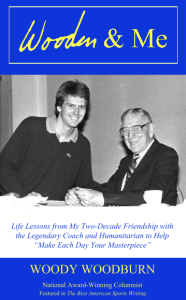Woody’s new novel “The Butterfly Tree” is available at Amazon (click here), other online retailers, and orderable at all bookshops.
*
From Woody’s column archives, November 27, 2010…
“Seek not to follow in the footsteps of the wise,” advised Japanese poet and philosopher Matsuo Basho. “Seek what they sought.”
Ages later another poet, the journalistic philosopher Chuck Thomas, wrote: “Never write a bad column when you can steal a good one.”
Chuck, who passed away one year ago (now 15) this coming week, wrote wise columns for The Star for more than half a century. The final time I saw him was in the hospital and he joked I should pinch hit for him until he got well. Heartbreakingly, he didn’t and now I feel like George Selkirk, the poor guy who followed in Babe Ruth’s giant footsteps.
Instead of playing right field in pinstripes in Yankee Stadium, I find myself writing in Chuck’s old space. His sacred spot. What an honor. And what pressure. I could use a therapy session with Chuck’s invented column character, “stressologist” Dr. Sigmund Schrink.
Following the master’s lead, I will partially fill this morning’s column with someone else’s words—Chuck’s, from two of the handful of letters he wrote me during my 13 years as a sportswriter for this newspaper.
Let me begin with one dated April 12, 1992, shortly after I confided my growing desire to move on to a major metropolitan newspaper. Using a manual typewriter he thoughtfully said, in part:
“Having been where you are, I can appreciate your frustration. I, too, wanted to prove I could play in the Big Leagues, but wasn’t willing to move to Cleveland or even Oakland to achieve that goal. Eventually, I realized that living in Ventura was more important to me and my family than being perceived as a genuine major leaguer.
“As that line from ‘Mission: Impossible’ goes, your challenge—should you choose to accept it—is just to keep writing great columns, and remember: Success is a journey, not a destination. Enjoy this time in your life, because your old Uncle Chuckles can promise that, someday, you’ll look back on these as good-old days.
“Even though it may seem to you that no one has noticed, I’m one of your fans who knows that you’re writing better now than ever—much better, with more depth, more variety and more class. And you’re writing rings around most of the other guys in the Big Leagues.”
His kind words not only swelled my spirits and buoyed my confidence, they guided me in a difficult decision when I was soon thereafter offered a big-time columnist position in Philadelphia. Realizing that living in Ventura was similarly more important to me and my young family than being perceived as a genuine major leaguer, I turned it down.
How much did I look up to Chuck? Perhaps the best answer is this: his notes and letters have always shared the same wooden box with penned heirlooms from my late mom, my departed grandfathers, and my idols Jim Murray and John Wooden.
Re-reading these missives from Chuck, who uniquely and affectionately often called me “The Wooder,” reminds me of something he said more than once in print: “If there’s someone whose friendship you treasure, be sure to tell them now—without waiting for a memorial service to say it.” I am thankful I listened and did so while Chuck was alive.
As I write my 14th column (now 14 years worth!) in this space, his venerable corner, the opening sentences of a letter dated July 12, 1995, seem eerily prophetic. Chuck, who started his career in sports, began:
“Woody – What happens to old sports columnists? Some of them become old news-page columnists.”
*
“Woody’s Holiday Ball Drive” reminder: New sports balls can be dropped off, or online orders delivered to, Jensen Design & Survey at 1672 Donlon St. in Ventura, 93003. Please email me about your gifts at woodywriter@gmail.com so I can add your generosity to this year’s tally and acknowledge you in a future column.
* * *
Essay copyrights Woody Woodburn
Woody’s new novel “The Butterfly Tree” is now available in paperback and eBook at Amazon (click here), other online bookstores, and is orderable at all bookshops.
*
Woody writes a weekly column for The Ventura County Star and can be contacted at WoodyWriter@gmail.com. Follow him on Twitter and Instagram at @

















 Woody’s highly anticipated new book “STRAWBERRIES IN WINTERTIME: Essays on Life, Love, and Laughter” is NOW available!
Woody’s highly anticipated new book “STRAWBERRIES IN WINTERTIME: Essays on Life, Love, and Laughter” is NOW available! 
 Serendipity smiled further on our side trip when the docent informed us that a anniversary ceremony commemorating Poe’s funeral was to be held at the Westminster Burying Ground, little more than a mile a way, starting in about five minutes.
Serendipity smiled further on our side trip when the docent informed us that a anniversary ceremony commemorating Poe’s funeral was to be held at the Westminster Burying Ground, little more than a mile a way, starting in about five minutes.